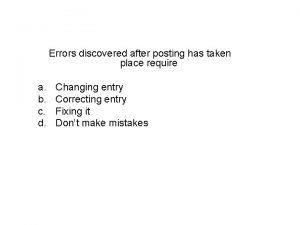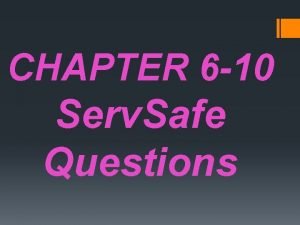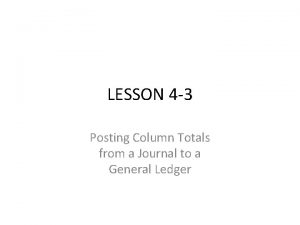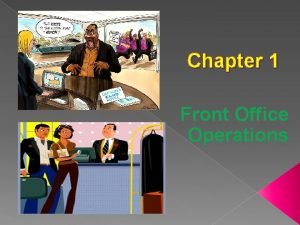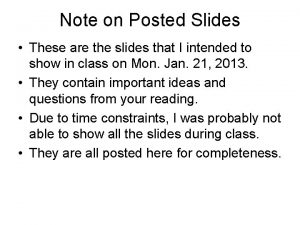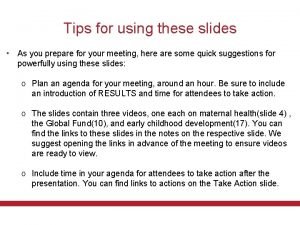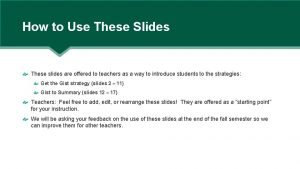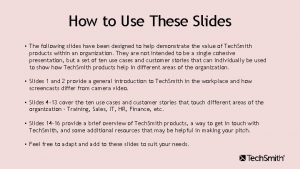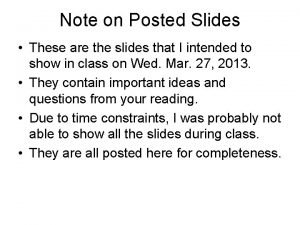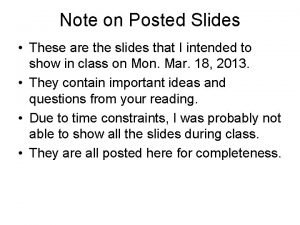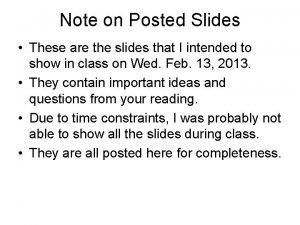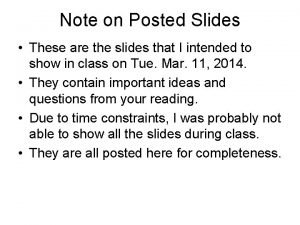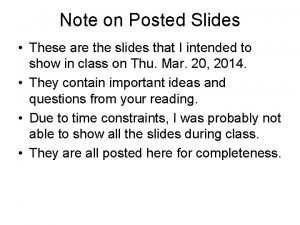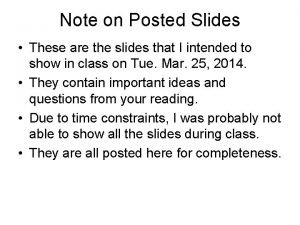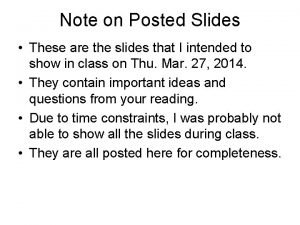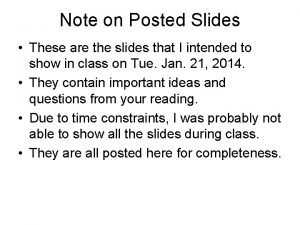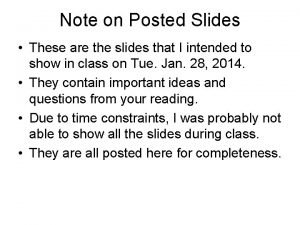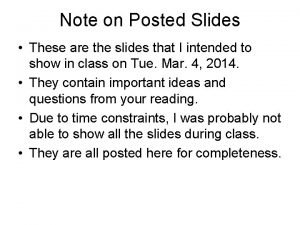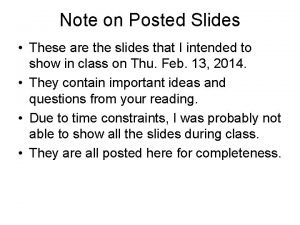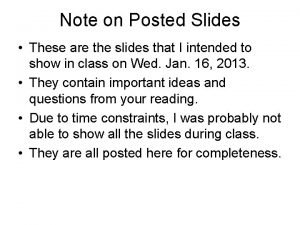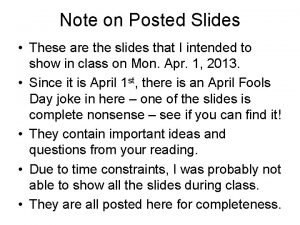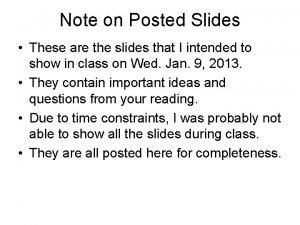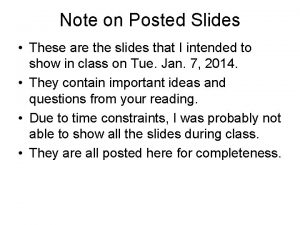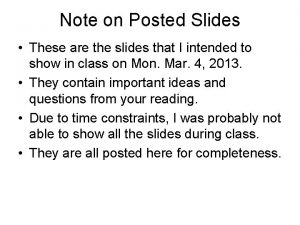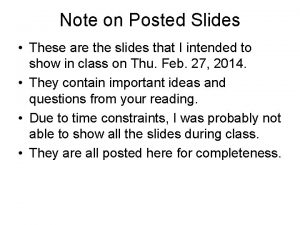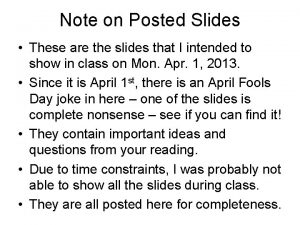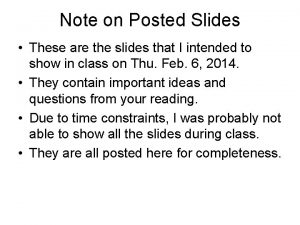Note on Posted Slides These are the slides








































- Slides: 40

Note on Posted Slides • These are the slides that I intended to show in class on Mon. Jan. 7, 2013. • They contain important ideas and questions from your reading. • Due to time constraints, I was probably not able to show all the slides during class. • They are all posted here for completeness.

PHY 205 H 1 S Physics of Everyday Life Class 1 • Welcome - please make yourself comfortable! • I am Jason Harlow, the instructor for this course • Today I will introduce the course, and start in on the first chapter: • Chapter 2: Newton’s First Law of Motion – Inertia • Conceptual Physics by P. G. Hewitt

Today’s Outline • Introduction Who am I? What is physics? • Run of the Course Clickers, Tutorials, Problem Sets, Tests and Exam • Starting Chapter 2 of Conceptual Physics (we are skipping chapter 1. . ) • Motion, Force, Inertia • Newton’s First Law

Who am I? • Jason Harlow, Senior Lecturer • B. Sc. in Physics at U of Toronto 1993 • Ph. D. in Astronomy and Astrophysics at Penn State 2000 • • I have been teaching at U of T for 8 years Contact Info: jharlow@physics. utoronto. ca 416 -946 -4071 Office: MP 121 B Office hours: Mondays: 4 -5 PM, Fridays: 9 -10 AM. In addition to these hours, you have are invited to call or email for an appointment, or just drop by my office.

Other Important Contacts • • • Ms. April Seeley, Course Administrative Assistant seeley@physics. utoronto. ca 416 -946 -0531 Office: MP 129 Office hours: Monday, Tuesday, Thursday, Friday 9: 30 am to 5: 00 pm, and Wednesdays from 9: 30 am to 4: 30 pm • Your T. A. – you will meet Jan. 9 -14

What is Physics? • Paul Hewitt, the author of the course textbook, says: “You know you can’t enjoy a game unless you know its rules; whether it’s a ball game, a computer game, or simply a party game. Likewise, you can’t fully appreciate your surroundings until you understand the rules of nature. Physics is the study of these rules, which show everything in nature is beautifully connected. So the main reason to study physics is to enhance the way you see the physical world. You’ll see the mathematical structure of physics in frequent equations, but more than being recipes for computation, you’ll see the equations as guides to thinking. ”

Physics—The Basic Science • Physical sciences include geology, astronomy, chemistry, and physics. • Life sciences include biology, zoology, and botany. • Physics underlies all the sciences.

Physics at U of T • Some of the top research fields in our department are: • Atmospheric – Observational and Computational • Biological Physics • Condensed Matter Physics – Theoretical and Experimental • High Energy Particle Physics – Theoretical and Experimental • Geophysics • Quantum Optics • Physics Education Research

Physics at U of T

Physics at U of T • Angry Birds at Summer Science Camp, led by Professor Sabine Stanley (Earth, Atmospheric and Planetary Physics)

Show of hands • What would you describe as your main area of study at U of T? – Humanities (Arts) – Rotman Commerce – Computer Science – Social Sciences – Other?

Who Should be Taking This Course? • To do well in this course, you must be familiar with life on earth, including moving, breathing and eating. • It also helps if you have some experience thinking about light, sound or music, and if you have ever used an electric device, or played with magnets. • There are no pre-requisites for this course but there are exclusions! • This course is primarily intended to be a breadth course for students in the humanities, social sciences, commerce, etc. You may not take this course if you have ever taken or are taking PHY 131, PHY 151, or any equivalent laboratory-based first year physics course.

My Goals for You • Begin to see physics in everyday life • Learn that physics isn’t frightening • Learn to think logically in order to solve physics problems • Develop and expand your physical intuition • Learn how things work • Begin to understand that the universe is predictable rather than magical • Obtain a perspective on the history of science and technology

My Goals for Me • To try to teach well and explain physics clearly, at an appropriate level. • To treat you with courtesy, respect and kindness. • To be fair. • To be in my office at scheduled office hours. • To answer emails within 48 hours. • To begin class at 10 after the hour and end on the hour.

What you need to buy (3 things) 1. The required textbook: "Conceptual Physics" 11 th edition, by Paul Hewitt © 2011 by Pearson Education. There is a custom edition for U of T St. George at the campus bookstore which includes only the chapters we will be covering in this course: 2 -8, 12 -16, and 19 -28. It also contains an i-clicker rebate coupon. Custom cover: Regular cover

What you need to buy (3 things) 2. An i-clicker personal remote. Available at the campus bookstore New: $36, used: $27. You will be registering this online with your UTORid for marks.

What you need to buy (3 things) 3. A calculator - this doesn’t need to be too fancy, but it must have SIN, COS, TAN buttons on it. For example a new Casio fx-260 is $16.

Tutorials • Tutorials begin this Wednesday • You should go to your tutorial section every Wednesday, Friday or Monday • See the web-site for your room location based on what TUT section you are enrolled in • Tutorial worksheets are worth 5% of the course mark. • Problem Set 1 will be distributed in tutorial this week and next Monday.

Tests • Test 1 is Wednesday, Jan. 30 during class time in EX 100 • Test 2 is Wednesday, Mar. 6 during class time in EX 100 • Each test is worth 17. 5% of the course mark. • The tests will involve a combination of multiple choice and written questions, which will test your understanding of course material and ability to think and apply what you have learned to simple problems and explaining phenomena. • A simple pocket calculator and a 5"× 3" index card with your own hand-written notes will be permitted during the tests.

Two balls are launched along a pair of tracks with equal velocities, as shown. Both balls reach the end of the track. Predict: Which ball will reach the end of the track first? • A • B • C: They will reach the end of the track at the same time © 2010 Pearson Education, Inc.

Demo: Two balls were launched along a pair of tracks with equal velocities. Both balls reached the end of the track. Observe: Which ball reached the end of the track first? • A • B • C: They reached the end of the track at the same time © 2010 Pearson Education, Inc.

Why does ball B reach the end of the track first? Explanation: • Balls A and B start and end with the same speed. • But while ball B is on the lower part, it is going faster than ball A because gravity has sped it up. • Its average speed is greater, so it gets there first! © 2010 Pearson Education, Inc.

Galileo’s Inertia Experiment • A ball rolls down a hill, along a flat part, and then up a hill again • It tends to roll up to the same height from which it was released (or a little less) • What if there was no second hill? • Q: What keeps an object going if it is already moving? • A: Its inertia.

Isaac Newton © 2010 Pearson Education, Inc. • Born in 1643, the year Galileo died. • Was a “physicist, mathematician, astronomer, natural philosopher, alchemist, and theologian and one of the most influential people in human history. ” (http: //en. wikipedia. org/wiki/Isaac_Newton) • In Philosophiæ Naturalis Principia Mathematica, published 1687, he described universal gravitation and the three laws of motion, laying the groundwork for classical mechanics.

What is a force? § A force is a push or a pull §A force acts on an object § Pushes and pulls are applied to something § From the object’s perspective, it has a force exerted on it • The S. I. unit of force is the Newton (N) • 1 N = 1 kg m s– 2 25 © 2010 Pearson Education, Inc.

What is a force? Vector quantity • a quantity whose description requires both magnitude (how much) and direction (which way) • can be represented by arrows drawn to scale, called vectors – length of arrow represents magnitude and arrowhead shows direction

Net Force Net force is the combination of all forces that change an object’s state of motion. Examples:

Net Force One person pushes a cart to the right with a force of 5 N. At the same time, a second person pushes the same cart to the left with a force of 10 N. What is the magnitude of the net force on the cart? A. 0 N B. 5 N C. 10 N D. 15 N

Net Force One person pushes a cart to the right with a force of 5 N. At the same time, a second person pushes the same cart to the left with a force of 10 N. What is the direction of the net force on the cart? A. To the left B. To the right

Net Force One person pushes a cart to the right with a force of 5 N. At the same time, a second person pushes the same cart to the left with a force of 10 N. The net force on the cart is 5 N to the left. Two forces are in opposite directions, so they subtract. The direction is determined by the direction of the larger force.

The Equilibrium Rule • The vector sum of forces acting on a nonaccelerating object equals zero. • In equation form: F = 0.

The Equilibrium Rule : Example A string holding up a bag of flour • Two forces act on the bag of flour: – Tension force acts upward. – Weight acts downward. • Both are equal in magnitude and opposite in direction. – When added, they cancel to zero. – So, the bag of flour remains at rest.

Normal Force The normal force on an object resting on a flat surface is an upward force on an object that is opposite to the force of gravity. Example: A book on a table compresses Atoms in the table, and the compressed atoms produce the support force.

Understanding Normal Force When you push down on a spring, the spring pushes back up on you. Similarly, when a book pushes down on a table, the table pushes back up on the book.

Equilibrium of Moving Things Equilibrium: a state of no change with no net force acting – Static equilibrium Example: hockey puck at rest on slippery ice – Dynamic equilibrium Example: hockey puck sliding at constant speed on slippery ice

Equilibrium of Moving Things A man pushes a crate with a force to the right. The downward gravity force is balanced by an upward normal force. normal push gravity Can this crate move at a constant velocity? A. Yes B. No, there must be another force involved.

Equilibrium of Moving Things Equilibrium test: whether something undergoes changes in motion Example: A crate at rest is in static equilibrium. Example: When pushed at a steady speed, it is in dynamic equilibrium.

1 Newton’s First Law The natural state of an object with no net external force on it is to either remain at rest or continue to move in a straight line with a constant velocity. © 2010 Pearson Education, Inc.

Thinking About Force § Forces exist due to interactions happening now, not due to what happened in the past § Consider a flying arrow § A pushing force was required to accelerate the arrow as it was shot § However, no force is needed to keep the arrow moving forward as it flies § It continues to move because of inertia 39 © 2010 Pearson Education, Inc.

The Reference Frame of a Moving Car Is it possible to juggle in a car that is moving at 100 km/h on the highway? Yes! Velocity is relative. If your laboratory is enclosed inside the back of a truck with no windows, there is no experiment you can do to determine whether the truck is at rest or moving along the highway at a steady speed.
 Insidan region jh
Insidan region jh What is debit note and credit note
What is debit note and credit note Example of signal word
Example of signal word What is a debit note
What is a debit note Difference between note making and note taking
Difference between note making and note taking Linear method of note taking
Linear method of note taking Goods received note
Goods received note Simple interest note vs simple discount note
Simple interest note vs simple discount note Difference between note making and note taking
Difference between note making and note taking After posting is completed there may be an error if
After posting is completed there may be an error if What is an infrared thermometer best used for servsafe
What is an infrared thermometer best used for servsafe Which column totals of a journal are posted?
Which column totals of a journal are posted? The only completely reliable backflow prevention
The only completely reliable backflow prevention Look mom europe
Look mom europe Room rack front office
Room rack front office Examples of momentum
Examples of momentum Starting from rest a marble first rolls down
Starting from rest a marble first rolls down A small child slides down the four frictionless slides
A small child slides down the four frictionless slides These slides
These slides These slides
These slides These slides
These slides Diễn thế sinh thái là
Diễn thế sinh thái là Vẽ hình chiếu vuông góc của vật thể sau
Vẽ hình chiếu vuông góc của vật thể sau Làm thế nào để 102-1=99
Làm thế nào để 102-1=99 Tỉ lệ cơ thể trẻ em
Tỉ lệ cơ thể trẻ em Lời thề hippocrates
Lời thề hippocrates đại từ thay thế
đại từ thay thế Quá trình desamine hóa có thể tạo ra
Quá trình desamine hóa có thể tạo ra Môn thể thao bắt đầu bằng từ chạy
Môn thể thao bắt đầu bằng từ chạy Cong thức tính động năng
Cong thức tính động năng Hát kết hợp bộ gõ cơ thể
Hát kết hợp bộ gõ cơ thể Khi nào hổ con có thể sống độc lập
Khi nào hổ con có thể sống độc lập Thế nào là mạng điện lắp đặt kiểu nổi
Thế nào là mạng điện lắp đặt kiểu nổi Các loại đột biến cấu trúc nhiễm sắc thể
Các loại đột biến cấu trúc nhiễm sắc thể Nguyên nhân của sự mỏi cơ sinh 8
Nguyên nhân của sự mỏi cơ sinh 8 Vẽ hình chiếu đứng bằng cạnh của vật thể
Vẽ hình chiếu đứng bằng cạnh của vật thể độ dài liên kết
độ dài liên kết Chó sói
Chó sói Thiếu nhi thế giới liên hoan
Thiếu nhi thế giới liên hoan điện thế nghỉ
điện thế nghỉ Một số thể thơ truyền thống
Một số thể thơ truyền thống









